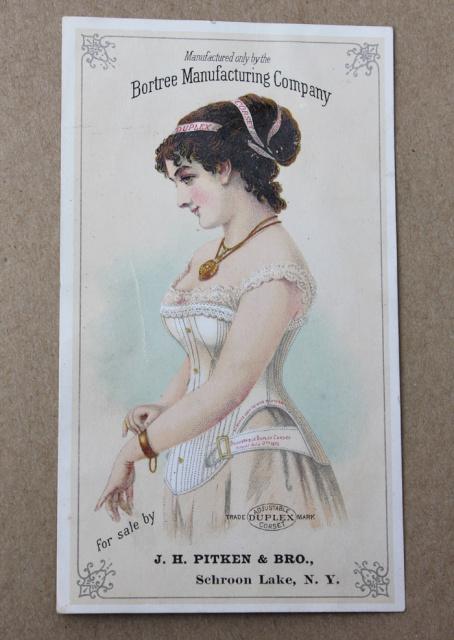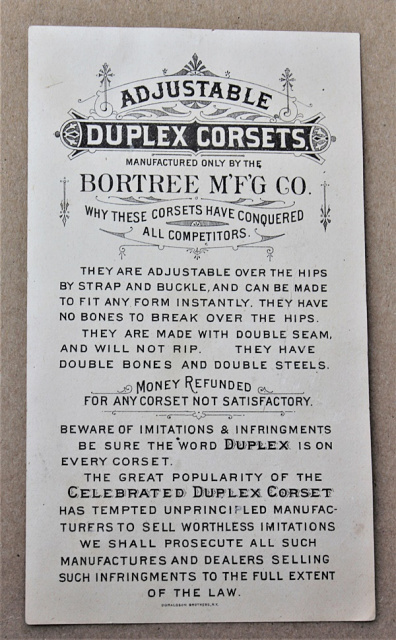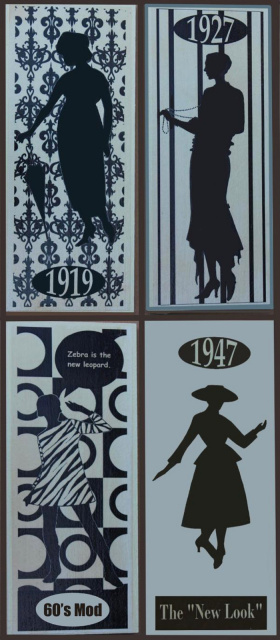The Corset, the Girdle, and the Bra
Woman Bound . . .
Woman Free


The age of constraint, bound by clothing, tells the story of women and oppression from the Victorian era to the freedoms of present day. Bone-bending corsets, crinolines, and bustles with heavily laden garments adorned in layers of fashioned fabrics formed the shape of the woman. Waist in, bust up, behind out was the exaggerated female s-curve silhouette of the 1800’s. The tight binding of the female presented her in delicate form and kept her from the pursuits of independence. Restrictive multiple-layer clothing would ensure her appeal to the man while naturally curbing freedom of movement. Deformed ribs and fetuses were evidence of the extent to which one was bound.
As we move through the ages, we see hips expand and waistlines cinched. We see waistlines rise, then disappear but not without the introduction of yet one other restrictive garment, the hobble skirt by French designer, Paul Poiret. By the time waistlines completely vanish, hemlines also rise. After the suffragette movement, clothing begins to soften, and restrictive undergarments slowly fade.
By the 1920’s, emancipation is reflected in both female behavior and manner of dress. The figure becomes boyish, the hair short. It is just a taste of what is to come four decades later. The mid-20’s and into the 30’s, the feminine physique is soft and bias draping is introduced by Madeleine Vionnet, still long and lean but revealing that soft and natural form.
Wartime brings boxy structures to shoulders and soon women have returned to the tight binding of undergarments by way of the girdle. Christian Dior introduces the “New Look,” and the woman of independence is juxtaposed with the housewife. She is bound by the girdle and the home. The 1950’s pave the way again to the next season of emancipation.
The mid-fifties brought in sultry tunes; the sounds of big band music, now married with seductive words of empowerment that conjure images of an elegant strip club. The sexy sounds of Julie London ushers in songs such as Cry Me a River, Nightlife, Daddy, and Go Slow. By today’s standards these sultry tunes may appear as though women were still giving away their power — the dawn of the term “sex kitten,” but the opposite was true; the emancipated woman was taking charge of her sexuality. It was the beginning of sexual freedom.
No longer must the woman be relegated to the bedroom as an expectation of marriage. We see both homemaker and dutiful wife, but the new single woman can choose her lovers and take charge of whom she invites into her own bedroom. Although far from the norm, this emancipated way of being indeed explores new possibilities.
As hemlines go up, waistlines disappear, and the bra finally comes off. Mary Quant enters the scene with a new innovation called the mini skirt. Like the 1920’s, the look becomes lean and boyish with short haircuts and garments with straighter lines. Restrictive clothing is a thing of the past and we enter a decade of women’s rights for equality. By the 1980’s, there comes a show of power with heavily padded shoulders and big hair. Women are taking up more space, figuratively and literally.

The corset makes its way back into fashion over the next decades. However, this time it is not imposed, but becomes a symbol of sexual and personal expression. Garments once hidden beneath layers of restrictive fashions have now made their way to the surface, displayed front and center. The corset and the bra peek boldly into the face of fashion showing off the female form with confidence.
She becomes the one in charge of her own look, her own statement, her own sexuality. Anything goes. Shorten the skirt, wear pants, show the midriff, ditch the bra, wear the corset. The woman is in charge, and she likes it that way. Should she choose to bind, it is with conscious selection. Should she choose to hide inside a baggy sweatshirt or an oversized jacket, it is her prerogative. And should she reveal all her fine curves and feminine qualities, it is her right to bodily freedom, expression of the mind and spirit.
We have come full circle; the woman no longer being dictated to, but rather choosing her pleasure. She can enjoy the niceties of the era, the romance, the binding, but she does so without the impositions and restrictions inflicted by the society in which she lives.
Don’t judge the woman of the past. Don’t wonder why she allowed herself to be controlled by a patriarchal society, for she was everyday working on your behalf. She made the sacrifice and paid the price, incrementally pushing past norms, expectations, and dictations. Be thankful and bless her for taking it upon herself to ask the questions. The questions which unlocked the doors to freedom, your freedom and mine.

